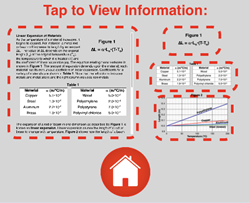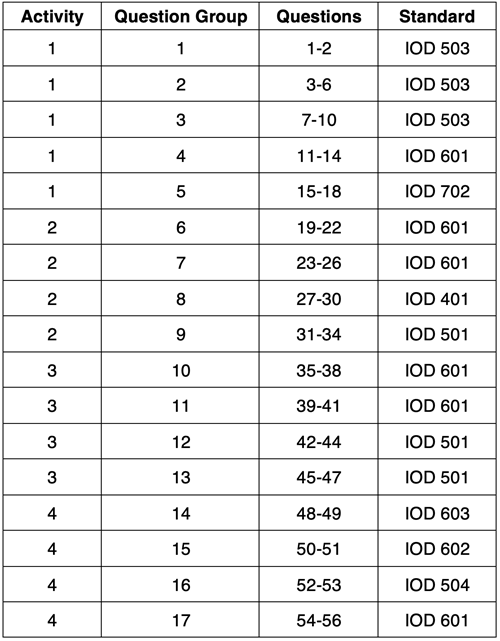About the Science Reasoning Center
 Highly Recommended
Highly RecommendedLike all our Science Reasoning Center activities, the completion of the Linear Expansion of Materials activity requires that a student use provided information about a phenomenon, experiment, or data presentation to answer questions. This information is accessible by tapping on the small thumbnails found on the bottom right of every question. However, it may be considerably easier to have a printed copy of this information or to display the information in a separate browser window. You can access this information from this page.
The Standards
The Linear Expansion of Materials task describes in quantitative terms the linear expansion that materials undergo when heated. The passage includes an equation, a table of coefficients of expansion, and a graph. Questions target a student's ability to use an equation to make predictions, to draw conclusions that are consistent with a model, to select points on a graph, to combine data from a table and a graph in order to compare the expansion of a material under various circumstances, to extrapolate outside the range of values provided by a graph, and to combine data from a table and a graph to make predictions about the amount of expansion a given length of material would undergo.
Success with the task requires some degree of proficiency with respect to ...
- Developing and Using Models (Science and Engineering Practice 2.3)
Develop, revise, and/or use a model based on evidence to illustrate and/or predict the relationships between systems or between components of a system. - Developing and Using Models (Science and Engineering Practice 2.4)
Develop and/or use multiple types of models to provide mechanistic accounts and/or predict phenomena, and move flexibly between model types based on merits and limitations. - Analyzing and Interpreting Data (Science and Engineering Practice 4.1)
Analyze data using tools, technologies, and/or models (e.g., computational, mathematical) in order to make valid and reliable scientific claims or determine an optimal design solution. - Using Mathematics and Computational Thinking (Science and Engineering Practice 5.3)
Use mathematical, computational, and/or algorithmic representations of phenomena or design solutions to describe and/or support claims and/or explanations. - Constructing Explanations and Designing Solutions (Science and Engineering Practice 6.1)
Make a quantitative and/or qualitative claim regarding the relationship between dependent and independent variables. - Patterns (Crosscutting Concept 1.5)
Mathematical representations are needed to identify some patterns. - Scale, Proportion, and Quantity (Crosscutting Concept 3.2)
Algebraic thinking is used to examine scientific data and predict the effect of a change in one variable on another (e.g., linear growth vs. exponential growth). - Stability and Change (Crosscutting Concept 7.1)
Much of science deals with constructing explanations of how things change and how they remain stable.
While Linear Expansion of Materials addresses the five NextGen Science and Engineering Practices and the three Crosscutting Concepts above, the activity drew its greatest inspiration from ACT's College Readiness Standards for Science Reasoning. The activity consists of 56 questions organized into 17 Question Groups that are spread across the three activities. The questions target a single strand (Interpretation of Data - IOD) of the College Readiness Standards. The code given for the standard includes three letters (IOD) to indicate the strand and three numbers to indicate the specific standard within that strand. Higher numbers are indicative of more complex science reasoning skills. The relationship between the questions and the standards is as follows:

Recommended: Print Passage, Tables, and Graphs
Also see: